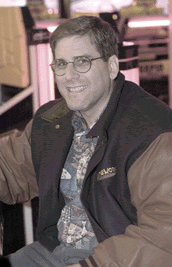 For well over a decade, Steven Kent has been documenting the history of video games, and he has dedicated himself to ensuring that all aspects of this hobby (passion?) of ours — which can be traced back to its roots before the era of pinball — be recognized for its rich heritage. His book, The Ultimate History of Video Games, is considered by many to be the definitive resource for enthusiasts and historians, and it is a book any self-respecting video gamer should own.
For well over a decade, Steven Kent has been documenting the history of video games, and he has dedicated himself to ensuring that all aspects of this hobby (passion?) of ours — which can be traced back to its roots before the era of pinball — be recognized for its rich heritage. His book, The Ultimate History of Video Games, is considered by many to be the definitive resource for enthusiasts and historians, and it is a book any self-respecting video gamer should own.
The author of more than eight books, including a successful series of science fiction novels, Kent is also a freelance journalist who has written for USA Today, The Chicago Tribune, and MSNBC. He was the first person to break the story about Nintendo’s DS, and the list of industry greats he has interviewed is staggering. Additionally, he’s penned a number of strategy guides and recently released his latest novel The Clone Republic, which is available through Amazon and at most major retailers. In his spare time, Kent continues to whup anyone foolish enough to challenge him at Super Puzzle Fighter.
Mr. Kent was kind enough to talk to Sega-16 about the Genesis and Sega’s rise and fall during the mid ’90s.
Sega-16: It seems that Sega’s attitude towards how big a part the American branch would have in the decision-making process began to change with the Saturn’s release? Would you agree?
Steven Kent: Nakayama-san never gave Sega of America its due. It’s interesting, Nakayama was brought into Sega Enterprises largely based on the efforts of an American–David Rosen, who was always impressed with Nakayama’s business sense. Once he got in, however, Nakayama seems to have decided that the Japanese knew best. He gave Kalinske some latitude when it came to marketing Genesis. Toward the tail end of the Genesis period, however, Nakayama’s pre-determination that the Japanese know best became very apparent. The Sega of America team was not consulted during the creation of Sega CD, for instance.
By the time Saturn came out, Nakayama was tightening the reins, but in private conversations I had with a number of Sega executives, I would hear stories about Nakayama bullying Kalinske and other SOA high-ups during the early ’90s as well. In fact, it should be remembered that a man was brought in as a possible replacement for Kalinske even before the launch of Saturn. Once Saturn launched, of course, the constant skinnings of Sega of America CEOs became more public.
Sega-16: Who at Sega do you think had the most influence on the success of the Genesis? Can it even be attributed to any one individual?
Steven Kent: Boy, there are so many people who deserve credit for this success. You can begin with the oft-overlooked Michael Katz. I will not say that Kalinske inherited a winning formula from Katz, but I will say he inherited some good cards. Katz was the one who decided to specialize in sports. Kalinske talks about taking Nintendo head-on in the advertising, but the “Nintendon’t” ads came out under Katz. I think it is fair to say that Katz, not Kalinske, came up with that approach.
Kalinske’s team came up with many smart moves–the lower price tag, replacing Altered Beast with Sonic as the pack-in, and a new and brash image. All those great ads came out under Kalinske and his team. I repeat, and his team. Kalinske surrounded himself with great people. While I will not claim to be an Eternal Champions fan, I think people like Mike Latham contributed immeasurably to Sega’s success. These were people who understood hardcore, casual, and every other level of gamer. They came up with great games.
Finally, I think you have to credit the American software team–including many of the Japanese game designers who came and worked in the United States. That would include Yuji Naka. It would include Mark Cerny. It would include Roger Hector. This was a true team effort put together by an extraordinary team.
Sega-16: Michael Katz recently stated that he felt Tom Kalinske’s team has received unfair praise over the years regarding certain aspects of the success Sega enjoyed during the mid ’90s. Do you think history has treated Katz’s tenure as president unfairly?
Steven Kent: It is a fact in politics and business that incoming regimes often benefit from programs designed by the teams they replaced. That said, I do not think Katz was going to sell the million units he was hired to sell. I do not think he would have adopted the attitude-intensive advertising campaign (including the SEGA scream). I think Kalinske pushed his Japanese bosses in ways that Michael would not have done.
Look, I know Michael Katz and respect his work. He is one of the great veterans of gaming, and his successes are legend. I do not think he is given enough credit for what he did to launch the Genesis. I think he did a competent job with Sega. By the same token, I think Kalinske and his team… and his team, deserve credit for pushing Sega to new heights.
S ega-16: Despite the major gains Sega made during 1992 and 1993, it seems like Hayao Nakayama lost confidence in Tom Kalinske almost overnight. What do you think was the reason for this change in position?
ega-16: Despite the major gains Sega made during 1992 and 1993, it seems like Hayao Nakayama lost confidence in Tom Kalinske almost overnight. What do you think was the reason for this change in position?
Steven Kent: I do not agree with this assessment. I doubt Nakayama ever had confidence in Kalinske. I think he felt that Japanese executives always knew best. That was part of the reason Mr. Shinobu Toyoda was installed in Sega of America.
You know how I keep on mentioning the team… Toyoda was an important part of that team. Nakayama had confidence in Toyoda, and Toyoda had confidence in the American team. He stood up for them. As far as Nakayama losing confidence overnight… I would have to disagree. Nakayama saw Game Gear fall. He saw 32X fail miserably despite a U.S. retooling. He saw Pico and Nomad utterly fail. He saw Sega CD go south as well as the Activator. Yes, many of these products came out of Japan and failed in Japan; but Sega of America had what Nakayama-san perceived as a more willing market. He wanted to see Kalinske and Toyoda walk on water, and their inability to market utter tripe disappointed him.
One last thing. You know, and I know, that Madden and NBA Live and many of those other made-in-America games were great. Nakayama didn’t. Japanese gamers did not like or respect many of the American-made games that became big hits here. I do not think Nakayama understood the cultural differences. I think he thought that Kalinske and company were selling schlock and he could not understand why they succeeded at selling American-made schlock but failed when it came to Japanese-made schlock sent over by Sega of Japan.
Sure, Sega did well selling later Sonic games, Streets of Rage, and translations of Yu Suzuki’s arcade hits, but that was expected. Nakayama wanted Kalinske to sell one million Sega CD drives.
Sega-16: Do you think there was really ever a chance for the Sega CD? The Night Trap controversy seemed to give it a small boost, but it never really caught on.
Steven Kent: Yes, I absolutely think that Sega CD could have succeeded, if it offered something more than additional storage space. If Sega CD had some of the modifications we saw in 32X, allowing for games that actually looked good, yes it could have been a contender.
Sega-16: Speaking of Night Trap, do you think Sega got a fair shake during the 1993 Senate hearings on video game violence? Bill White seemed to get grilled compared to how Nintendo’s Howard Lincoln was treated.
Steven Kent: Did Sega get a fair hearing in D.C.? No. But I think that backfired on Nintendo. First of all, Nintendo wanted Sega to get hauled before Congress and exposed as a corrupter of American youths. What Nintendo did not expect was that the stigma would spread. Nintendo did not expect to sustain splash damage. Once the senators got the hang of bullying Sega, they turned on Nintendo and asked Howard Lincoln many of the same question they had been asking Bill White.
I think the opening days were filled with Sega bashing. I think that Nintendo joined Sega on the grill by the time the ordeal was over. Further, I think there were those in and out of the industry who felt that Nintendo was the disgraced teacher’s pet–an instigator who ultimately joined the victims. I think Nintendo lost prestige in the industry because of that perception.
Sega-16: You wrote in the Ultimate History of Video Games that Sega could have perhaps weathered the Saturn’s shaky start in the U.S. had it continued supporting the Genesis in 1995. A change in strategy for Japan seemed logical, given the Mega Drive’s weak performance there, but many question Sega taking action worldwide. Why do you think Hayao Nakayama decided to discontinue the Genesis in America and Europe, despite its huge user base and strong sales?
Steven Kent: Ultimately, I do not think Nakayama understood the industry. I think he made many of the same mistakes and good decisions made by Ray Kassar at Atari. He saw the popularity of Virtua Fighter (in Japan) and thought that the new system would sell like hot cakes. He did not understand the dynamics. I think he thought that the average consumer would see Virtua Fighter and forget all about his Genesis. They would not want to play Genesis anymore. He did not understand the dynamics of the transition. It was a fatal mistake–vocationally speaking.
Sega-16: Was there really such horrible communication between the American and Japanese branches of Sega during the mid ’90s? Was there really that secret rivalry we all hear about?
Steven Kent: Hell yes! Stolar, Kalinske, Moore, they all will tell you the same thing: they dreaded going to Japan. Look, I told you things were bad when Genesis was selling well in America and lagging in Japan. How warm a reception do you think Kalinske got when Saturn was dying in America and popular in Japan?
Sega-16: Were the 32X and Saturn actually developed separately (and some say in secret) from each other?
Steven Kent: Oh, good question. I don’t know. I have spoken with several former Sega-ites who swear on the Bible and their mothers’ graves that 32X was originally planned to be upgradable to play Saturn games. Is it true? I don’t know, but I believe that they believe it was true.
That does not answer your question, I know.
The 32X as we know it was not the 32X that came out of Japan. The unit developed in Japan only added better sound and more colors to Genesis games. Joe Miller, the man who is often blamed for the failure of 32X, is not given credit for the very brave stance he took. He looked at the original 32X and said, “This isn’t good enough.” The 32X he created added processing power. It still wasn’t good enough, but it was better. I doubt Miller’s 32X was co-developed with Saturn. I don’t know about the one from Japan.
Sega-16: Sega has been sort of dragging its feet over the years about revisiting its 8 and 16-bit catalogue, and many of the games that have received updates have not been so warmly welcomed (Altered Beast, Golden Axe). Do you think the recent announcement that Genesis games will be available for download on the Nintendo Wii console will motivate Sega to bring back more of its classic franchises?
Steven Kent: I think they would have had more effect had Nintendo not named its new console the Wii. Have you ever heard about the Chevy Nova fiasco in South America? In Spanish, No Va means “It does not go.” Wii is an even worse name than Nova as far as I am concerned. If the Wii inspires Sega to do anything, it should inspire Sega to return to the hardware market with a good console with a good name. Microsoft, Sony, and Nintendo are all looking kind of inept these days.
Okay, so back to your question… If Sega got a good response to its 16-bit games it could be a motivator. I have known Hisao Oguchi for a long time. I first interviewed him in 1995. He’s a smart guy. I think he should be managing a game team and not the company–but that is more of a token of my absolute respect for his old team’s ability to make great games on a reasonable budget.
The truth is that so much of what made the Sega of old so remarkable is gone. It left when Sega went software only. Sega was a company that needed the pressure of supporting a hardware platform. Without that, the company seems lazy and complacent. The Sega of today strikes me as a weak replica of the Sega of 1993-2001.
 Sega-16: Do you think Genesis games on the Wii (and possibly Xbox Live Arcade) can truly be a major draw in today’s industry?
Sega-16: Do you think Genesis games on the Wii (and possibly Xbox Live Arcade) can truly be a major draw in today’s industry?
Steven Kent: You know what? Streets of Rage, Mickey Mouse in Castle of Illusion, Shinobi, Beyond Oasis, and a bunch of other Genesis games are still great. You look at them and they look old, but the play mechanics are unmatched.
I had the chance to work on GameTap, the Turner Broadcasting classic games site. I can tell you that while most of the Atari 2600 and Intellivision games are too hopelessly dated, a good share of those Genesis games are still great to play. Look, at the launch of Xbox 360, everyone agreed that the retail software was uninspiring and that Xbox Live Arcade stole the show. Unless Nintendo has a much better launch library than it had for GameCube, there will be plenty of reason for early Wii-pies to download Genesis games.
Sega-16 would like to thank Mr. Kent for taking the time to chat with us. Be sure to head over to his website for a more comprehensive look at the accomplishments of one of gaming’s foremost journalists.

Recent Comments